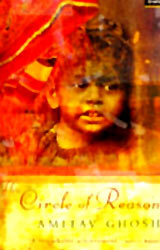This novel `The Circle of Reason` is a saga of escape and pursuit, this novel chronicles the adventures of Alu, a young master weaver who is wrongly suspected of being a terrorist. He was chased from Bengal to Bombay and on through the Persian Gulf to North Africa by a bird-watching police inspector, Alu encounters along the way a cast of characters as various and as colorful as the epithets with which the author adorns them.
In today`s world Amitav Ghosh is one of the most widely known Indian writing in English. In his lifetime he has done many work His books include The Circle of Reason, The Shadow Lines, In An Antique Land, Dancing in Cambodia, The Calcutta Chromosome, The Glass Palace, etc. The author Amitav Ghosh was born in Calcutta in 1956. He studied at St. Stephens College, Delhi, St. Edmund Hall, Oxford, and the Faculty of Arts, University of Alexandria. He worked for the Indian Express newspaper in New Delhi and he also achieved his doctorate degree in Oxford before he wrote his first novel. The Circle of Reason won the Prix Medici Etranger, one of France`s top literary awards, and The Shadow Lines won the Sahitya Akademi Award, India`s most prestigious literary prize as well. The Calcutta Chromosome won the Arthur C. Clarke Award for 1997 and The Glass Palace won the Grand Prize for Fiction at the Frankfurt International e-Book Awards in 2001. Amitav Ghosh was also the winner of the 1999 Pushcart Prize, which is a leading literary award, for an essay that was published in the Kenyon Review.
Synopsis:
 In `The Circle Of Reason`, the author Amitav Ghosh describes the story vividly with brilliantly imagined characters. The central character of the story is an eight-year-old boy, with a congenital physical disorder, and much to his ill fate, his strange appearance becomes one of the causes for his troubles. And it is here that we see rare literary brilliance. The author successfully creates a feeling of optimism, even though there is sheer chaos surrounding the main protagonist. His fate keeps taking strange twists and yet, he shows a rare strength of coming back and taking charge of his destiny. The other characters in the book, are equally awe inspiring and their individual characteristics are so diverse, that the author takes the readers on a fantasy ride, keeping you within the lands of the strictly possible at the same time. Another important aspect of the storyline is its locations. The book describes some beautiful location though separated by great distance, the way the author blends them into the storyline, it gives you a practical view of what the boy might be facing. After reading the book anyone will try to visualize the story. The book is divided into three sections namely `Satwa`, which means Reason, `Rajas`, which means Passion, and `Tamas`, which means Death. The distinction between traditional idealism and modern day free value thought is brought out in a very subtle way.
In `The Circle Of Reason`, the author Amitav Ghosh describes the story vividly with brilliantly imagined characters. The central character of the story is an eight-year-old boy, with a congenital physical disorder, and much to his ill fate, his strange appearance becomes one of the causes for his troubles. And it is here that we see rare literary brilliance. The author successfully creates a feeling of optimism, even though there is sheer chaos surrounding the main protagonist. His fate keeps taking strange twists and yet, he shows a rare strength of coming back and taking charge of his destiny. The other characters in the book, are equally awe inspiring and their individual characteristics are so diverse, that the author takes the readers on a fantasy ride, keeping you within the lands of the strictly possible at the same time. Another important aspect of the storyline is its locations. The book describes some beautiful location though separated by great distance, the way the author blends them into the storyline, it gives you a practical view of what the boy might be facing. After reading the book anyone will try to visualize the story. The book is divided into three sections namely `Satwa`, which means Reason, `Rajas`, which means Passion, and `Tamas`, which means Death. The distinction between traditional idealism and modern day free value thought is brought out in a very subtle way.
`The Circle of Reason` is written by Amitav Ghosh and is published by the different publishing house namely Viking adult, Hamish Hamilton Ltd., Mariner books, Granta books, and also Penguin Books.













